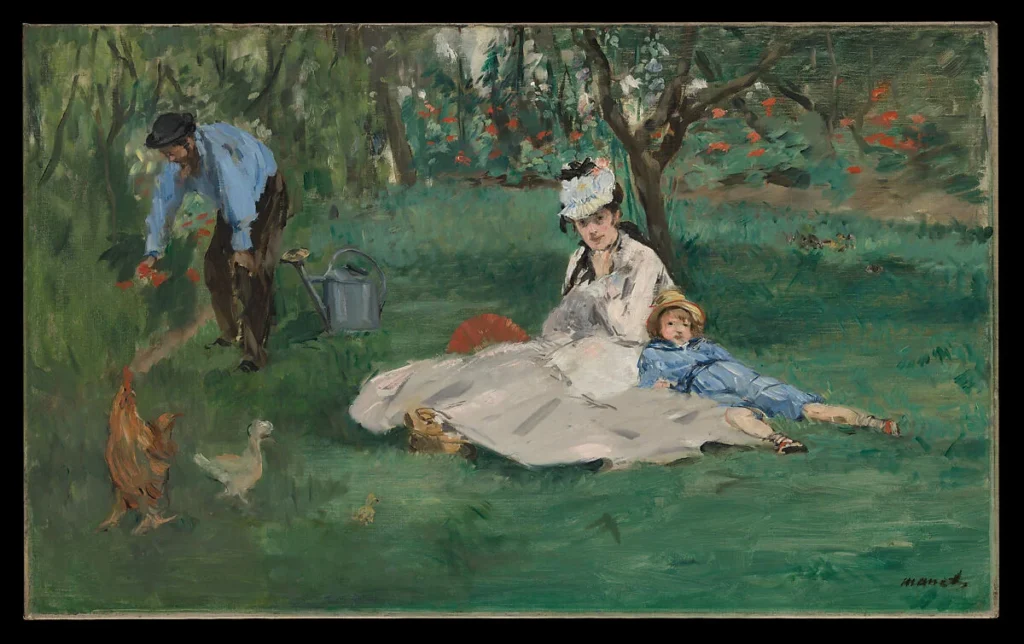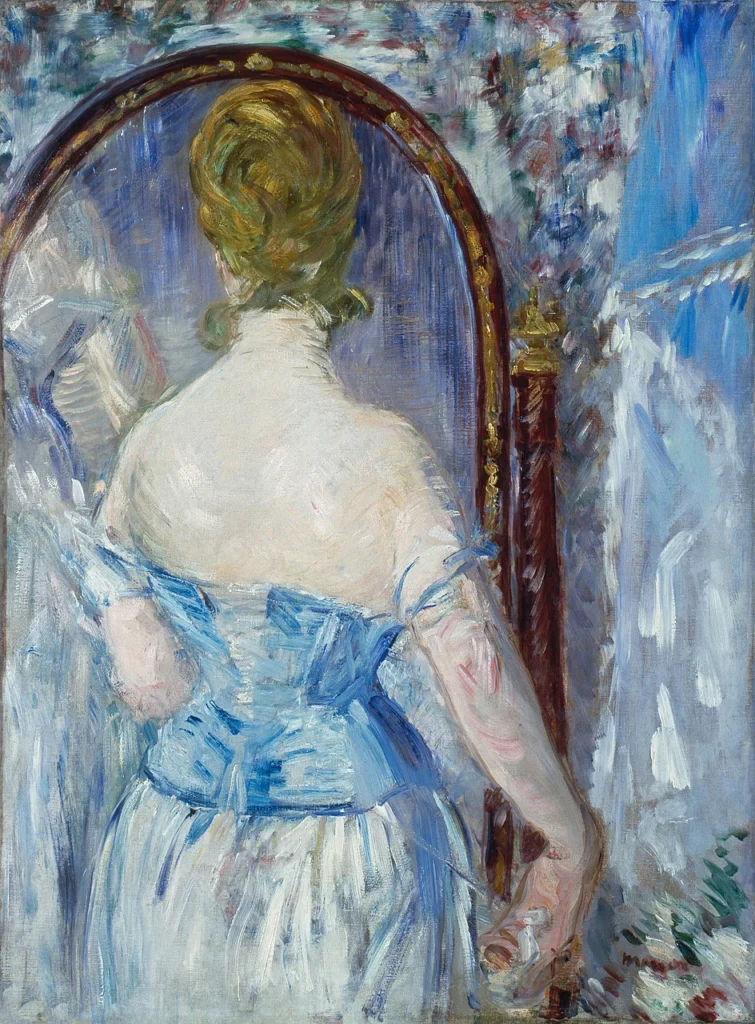Édouard Manet, a prominent figure in 19th-century art, stands as a pioneer who spearheaded a remarkable artistic revolution. With his innovative approach, Manet challenged the traditional norms and conventions of his time, setting the stage for the emergence of modern art.
Manet’s artistic revolution was characterized by a bold departure from the established academic standards prevalent during his era. Rejecting the idealized representations and meticulous details of classical art, Manet opted for a more direct and honest portrayal of reality. His brushstrokes captured the essence of the moment, emphasizing the immediacy and spontaneity of the subjects.
One of the notable aspects of Manet’s artistic revolution was his exploration of unconventional subjects. He ventured beyond the realm of historical and mythological scenes, delving into the everyday life of ordinary individuals. Through his compositions, Manet highlighted the beauty and significance of the mundane, immortalizing scenes from contemporary Parisian society.
Édouard Manet ‘s innovative use of color and light also played a pivotal role in his artistic revolution. Departing from the traditional tonal palette, he introduced vibrant and contrasting hues, creating a visual impact that resonated with the viewer. This manipulation of color and light not only added depth and dimension to his works but also conveyed a sense of modernity and freshness.
Furthermore, Manet’s daring compositions challenged the established rules of perspective and spatial arrangement. He experimented with unconventional angles and cropping, fragmenting the visual plane to create a sense of dynamism and intrigue. This departure from traditional compositional techniques added a unique and captivating dimension to his artwork.

Breaking the Chains of Tradition: Manet’s Avant-Garde Approach
Édouard Manet’s avant-garde approach to art shattered the chains of tradition, establishing him as a revolutionary figure in the art world. With his innovative techniques and fearless exploration, Manet challenged the established norms and pushed the boundaries of artistic expression.
At a time when academic standards dictated the art scene, Manet boldly stepped forward with a fresh perspective. He defied the conventional rules and expectations, daring to create works that defied categorization. His art stood as a testament to his refusal to conform, as he fearlessly embraced new ideas and techniques.
One of the key aspects of Manet’s avant-garde approach was his rejection of established subject matter. While traditional art often focused on grand historical narratives or mythological scenes, Édouard Manet sought inspiration from the everyday world around him. He celebrated the beauty of the ordinary, shedding light on the overlooked aspects of contemporary life.
Moreover, Manet’s avant-garde approach extended to his use of brushstrokes and application of paint. He abandoned the meticulous, smooth surfaces typically associated with academic art, opting instead for bold, visible brushwork. This deliberate departure from convention added a raw and expressive quality to his paintings, allowing viewers to witness the artist’s hand at work.
Furthermore, Manet’s avant-garde approach encompassed his rejection of traditional techniques of perspective and spatial arrangement. He embraced unconventional angles, fragmented compositions, and flattened perspectives.
In summary, Édouard Manet’s avant-garde approach to art revolutionized the way artists approached their craft. By breaking free from tradition and embracing new ideas, he opened doors to artistic experimentation and pushed the boundaries of expression.
Portraits with a Twist: Manet’s Provocative Gaze
Édouard Manet’s captivating portraits offer a unique and provocative gaze into the subjects he depicted. Going beyond conventional portraiture, Manet infused his works with an intriguing twist that challenged societal norms and expectations.
Manet’s approach to portraiture was marked by his ability to capture the essence and individuality of his subjects. Rather than presenting idealized representations, he sought to reveal the true nature of the individuals he painted. With his bold brushstrokes and keen observation, Manet conveyed a sense of honesty and raw emotion in his portraits.
Furthermore, Manet’s portraits often defied the traditional roles and expectations assigned to individuals based on their gender or social status. He presented women with agency, portraying them as confident and self-assured rather than passive objects of admiration. Manet’s unconventional portrayal of women in his portraits challenged the prevailing notions of femininity and sparked conversations about gender roles.
In addition to his innovative depiction of individuals, Manet’s use of composition and visual elements added a provocative twist to his portraits. He strategically positioned his subjects within the frame, incorporating objects and backgrounds that provided subtle hints and narratives. This added layer of symbolism and ambiguity invited viewers to engage with the artwork on a deeper level, stimulating their curiosity and imagination.
Édouard Manet ‘s portraits with a twist not only pushed the boundaries of traditional portraiture but also reflected his keen observation of society. His ability to capture the complexities of human character and challenge societal norms through his art contributed to his reputation as a trailblazer in the art world.
Scandal and Controversy: Manet’s Defiant Masterpieces
Édouard Manet’s artistic career was marked by a series of scandalous and controversial masterpieces that challenged the societal norms of his time. Through his audacious and defiant approach to subject matter and execution, Manet pushed the boundaries of acceptability, causing a stir in the art world and beyond.
One of the central factors contributing to the scandalous nature of Manet’s works was his choice of unconventional subjects. He fearlessly portrayed scenes and individuals that were considered taboo or controversial at the time. Whether it was depicting a prostitute or a reclining nude, Manet confronted the viewer with subject matter that deviated from the established standards of propriety.
Moreover, it was not only the choice of subjects that caused outrage but also Manet’s unconventional treatment of them. He defied conventional techniques and styles, employing bold brushwork, loose composition, and flattened perspective. These stylistic choices challenged the established notions of artistic beauty and technical mastery, leading to fierce debates and criticism.
One of Édouard Manet’s most infamous works, “Olympia,” incited a significant scandal upon its debut. The painting featured a reclining nude woman, a direct reference to Titian’s Venus of Urbino, but with a daring twist. Manet presented the female figure as a contemporary, confident courtesan, unapologetically gazing at the viewer.
Manet’s defiance in the face of societal expectations and his willingness to challenge the established order through his art left a lasting impact on the art world. His masterpieces continue to evoke strong reactions and inspire discussions about the boundaries of acceptability and the power of artistic expression.
Reimagining Reality: Manet’s Impressionistic Vision
Édouard Manet’s artistic genius extended beyond the realm of traditional representation, as he embraced an impressionistic vision that reimagined reality. Through his innovative use of brushwork, color, and light, Manet captured fleeting moments and sensations, immersing the viewer in a world of impressions.
Manet’s impressionistic vision was characterized by his ability to convey the atmosphere and essence of a scene rather than providing a meticulous depiction of details. He employed loose brushstrokes and rapid, spontaneous application of paint to capture the fleeting nature of light and movement. This technique created an illusion of vibrancy and energy, as if the scenes were captured in a momentary glimpse.
Furthermore, Manet’s use of color in his impressionistic works was revolutionary. He departed from the traditional tonal palette, instead incorporating vibrant and contrasting hues to evoke the shifting play of light and shadow. Through his masterful manipulation of color, he infused his paintings with a sense of liveliness and depth.
Édouard Manet’s impressionistic vision also extended to his choice of subjects. He often depicted scenes from modern urban life, capturing the hustle and bustle of city streets, bustling cafés, and leisure activities. His keen observation of contemporary society and his ability to translate it onto the canvas allowed viewers to experience the vibrancy and energy of the changing world around them.
Moreover, Manet’s impressionistic vision transcended the boundaries of traditional genres. He blurred the lines between portraiture, landscape, and genre scenes, creating a sense of fluidity and spontaneity. This fusion of genres added to the overall impressionistic quality of his works, inviting viewers to engage with the paintings on an emotional and sensory level.

The Birth of Modernism: Manet’s Influence on the Art World
Édouard Manet’s profound influence on the art world marked a pivotal moment in the birth of modernism. Through his bold experimentation, rejection of traditional norms, and willingness to challenge the status quo, Manet paved the way for a new era in artistic expression.
Manet’s impact on modernism can be seen in various aspects of his work. His innovative techniques, such as his loose brushwork and flattened perspective, directly influenced the development of the Impressionist movement. Artists inspired by Manet began to explore similar stylistic approaches, emphasizing the capture of light, color, and atmospheric effects in their works.
Furthermore, Manet’s subject matter and treatment of it foreshadowed the themes and approaches of later modernist movements. His focus on contemporary life, rejection of idealized representations, and exploration of unconventional angles challenged the traditional conventions of art.
Manet’s influence also extended to the concept of artistic autonomy and the artist’s role in society. He asserted his independence and artistic integrity by refusing to conform to academic standards and societal expectations.
Moreover, Manet’s work sparked important conversations and debates about the nature and purpose of art. By presenting controversial subject matter and defying traditional techniques, he forced viewers to confront their preconceived notions and question the boundaries of artistic expression.
In summary, Édouard Manet’s influence on the art world was instrumental in the birth of modernism. His innovative techniques, unconventional subject matter, and challenging of artistic norms paved the way for future artistic movements. Manet’s legacy as a trailblazer and his impact on the development of modern art continue to shape the artistic landscape to this day.
Beyond the Canvas: Manet’s Exploration of Social Commentary
Édouard Manet’s artistic endeavors went beyond the confines of the canvas, as he delved into the realm of social commentary. Through his works, he tackled pressing social issues and used art as a medium for cultural critique and reflection.
Manet’s exploration of social commentary was evident in his choice of subjects. He portrayed scenes from contemporary Parisian society, shedding light on the stark realities of urban life. Whether it was depicting the working class, the bourgeoisie, or the marginalized, Manet captured the complexities of social dynamics and exposed the disparities and inequalities that existed in society.
Moreover, Manet’s portrayal of his subjects often carried subtle symbolic messages. Through his deliberate inclusion of objects, settings, or gestures, he commented on societal norms, power dynamics, and political ideologies. His art became a means to challenge the status quo and provoke conversations about social issues that were often swept under the rug.
One notable example of Manet’s social commentary is his painting “The Execution of Emperor Maximilian.” The artwork depicted the execution of Maximilian I, the former Emperor of Mexico, by a firing squad. Through this powerful image, Manet condemned the abuse of power, the brutality of war, and the disregard for human life.
Furthermore, Édouard Manet ‘s exploration of social commentary extended to his depictions of women and their role in society. He challenged the conventional portrayal of women as passive objects of desire and instead presented them as individuals with agency and autonomy. Manet’s female figures often confronted the viewer with a direct gaze, defying societal expectations and raising questions about gender roles and equality.
Legacy and Enduring Influence: Manet’s Lasting Artistic Impact
Édouard Manet’s artistic legacy extends far beyond his lifetime, leaving an enduring influence on the art world. His bold experimentation, revolutionary approach, and willingness to challenge artistic conventions continue to shape and inspire artists to this day.
One aspect of Manet’s lasting artistic impact is his role in bridging the gap between traditional academic art and the emergence of modernism. His rejection of academic standards and his exploration of new techniques and subject matter set the stage for the radical artistic movements that followed, such as Impressionism and Post-Impressionism.
Furthermore, Manet’s emphasis on capturing the essence of the moment and the fleeting nature of reality resonates with contemporary artists. His ability to convey emotion, atmosphere, and personal interpretation through his brushstrokes and composition continues to inspire artists to explore their own unique perspectives and push the boundaries of representation.
Additionally, Manet’s exploration of social commentary and his willingness to challenge societal norms have left a lasting impact on the role of art in society. His use of art as a medium for cultural critique and reflection has influenced generations of artists who seek to use their work to address pressing social issues and provoke meaningful conversations.
Moreover, Manet’s influence can be seen in the realm of portraiture, where artists continue to experiment with unconventional approaches to capturing the individuality and complexity of their subjects. His ability to reveal the true nature of his subjects, beyond superficial appearances, has inspired contemporary portrait artists to delve deeper into the psychological and emotional aspects of portraiture.
Conclusion

Are you intrigued by the revolutionary artistry of Édouard Manet? Do you want to delve deeper into his innovative techniques, provocative subject matter, and lasting impact on the art world? Look no further! In the website Crisis International CH is your gateway to a comprehensive exploration of all things Manet. Explore the range of Manet’s subjects, from his iconic portraits with a twist to his bold and controversial masterpieces. Unravel the layers of social commentary embedded in his art, as he fearlessly challenged societal norms and provoked thought-provoking conversations.
Contact CRIS GONZALEZ INTERNATIONAL STUDIO 📞
Looking to get in touch? Here’s how you can reach out to Cristian Damian Gonzalez Lahmann, the heart behind our artistic endeavors and social research initiatives:
📱 Social Media:
- Facebook: Cris Internacional
- Instagram: Cris Internacional
- Twitter: Cris RRII
- Linkedin: Cris Internacional
- Youtube: Cris Internacional
📧 Email: [email protected]
📞 Phone/WhatsApp: +41767664121
🏢 Address: CRIS GONZALEZ INTERNATIONAL STUDIO Leuernweg 32, 3250 Lyss Canton of Bern, Switzerland
🌐 Website: Cris International
Feel free to connect with us for inquiries, collaborations, or simply to say hello! We look forward to hearing from you. ✨
